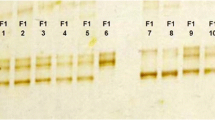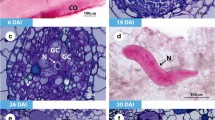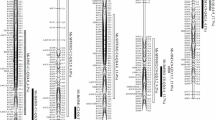Summary
Accession No. 1 of Aegilops variabilis has complete resistance to the root knot nematode, Meloidogyne naasi. F2 segregation in a cross between this and two susceptible accessions showed that one dominant gene named Rkn-mn1 prevented development of galls on the roots and consequently of female nematodes. The study of the numbers of females in galls on the F2 plants allowed detection of a recessive gene, Rkn-mnAv, suppressing development of J2 larvae into females. The presence of Rkn-mnAv also resulted in a decrease of the level of galling. Rkn-mn1 has already been introduced into wheat. The interest in transferring also Rkn-mnAv is discussed in relation to extending durability of the nematode resistance.
Similar content being viewed by others
References
Balhadere, P. & F. Person-Dedryver, 1991. Characteristics of the incomplete resistance of Hordeum chilense to the root knot nematode Meloidogyne naasi FRANKLIN-Description of a newly conceived test to detect the resistance. Plant Breeding 107: 342–345.
Cook, R., P.A. York & B.H. Chew, 1976. Variation in host reaction to the cereal root knot nematode Meloidogyne naasi and new host records. Rep. Welsh Plant Breed. Stn. for 1976, 71–72.
Cook, R. & P.A. York, 1981. Genetics of resistance to Heterodera avenae and Meloidogyne naasi. Proc. 4th. Int. Barley Genet. Symp. Edinburgh. Edinburgh University Press, 418–424.
Franklin, M.T., 1979. Economic importance of Meloidogyne in temperate climates. In: Root knot nematodes (Meloidogyne species) Systematics, Biology and Control. Academic Press, London, 331–339.
Kawahara, T., 1988. Variation in chromosome structures in Aegilops kotschyi Boiss. and Ae. variabilis Eig. In: T.M. Miller & R.M.D. Koebner (Eds.) Proc. 7th. Int. Wheat Genet. Symp., Cambridge, 99–104. I.P.S.R., Cambridge.
McIntosh, R.A., G.E. Hart & M.D. Gale, 1990. Catalogue of gene symbols for wheat (1990 supplement). Wheat Information Service 70: 29–50.
Person-Dedryver, F., 1984. Les céréales à paille hôtes de Meloidogyne naasi Franklin. I. Mise au point de méthodes et résultats préliminaires d'évaluation de la résistance ou du caractère multiplicateur. Agronomie 4: 977–985.
Person-Dedryver, F. & J. Jahier, 1985. Les céréales à paille hôtes de Meloidogyne naasi Franklin. III. Recherche de sources de résistance parmi les espèces voisines du blé tendre. Agronomie 5: 573–578.
Person-Dedryver, F., J. Jahier & T.M. Miller, 1990. Assessing the resistance to cereal root knot nematode, Meloidogyne naasi, in a wheat line with the added chromosome arm 1HchS of Hordeum chilense. J. Genet. Breed. 44: 291–296.
Yen, Y. & G. Kimber, 1990. Reinvestigation of the S genome in Triticum kotschyi. Genome 33: 521–524.
Yu, M.Q., J. Person-Dedryver & J. Jahier, 1990. Resistance to root knot nematode, Meloidogyne naasi Franklin transferred from Aegilops variabilis Eig. to bread wheat. Agronomie 6: 451–456.
Yu, M.Q. & J. Jahier, 1992. Origin of Sv genome of Aegilops variabilis and utilization of the Sv as analyser of the S genome of the Aegilops species in the Sitopsis section. Plant Breeding (in press).
Author information
Authors and Affiliations
Rights and permissions
About this article
Cite this article
Yu, M.Q., Jahier, J. & Person-Dedryver, F. Genetics of two mechanisms of resistance to Meloidogyne naasi (FRANKLIN) in an Aegilops variabilis Eig. accession. Euphytica 58, 267–273 (1991). https://doi.org/10.1007/BF00025259
Received:
Accepted:
Issue Date:
DOI: https://doi.org/10.1007/BF00025259




